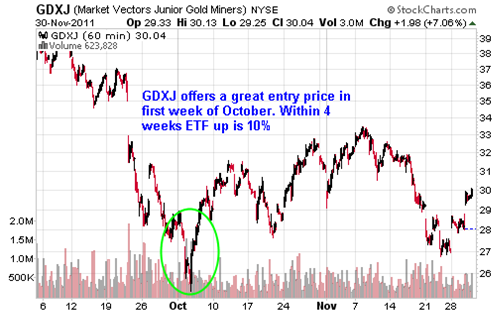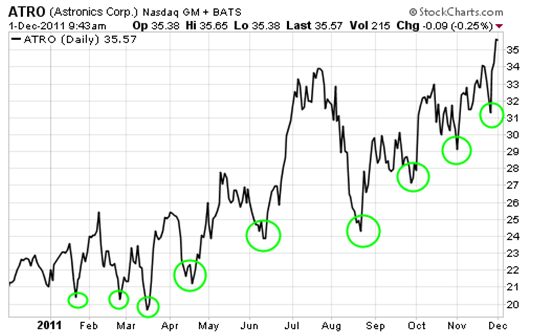"That's exactly the strategy our small cap team has been using for the past couple of years. And they've been killing it…"
This was my friend – an advisor at a mid-cap mutual fund – commenting when I outlined a strategy that's been working to nab quick profits with small cap trades over the past couple of months.
Today, I want to explain the strategy that small cap funds use to 'kill it' so you can put it to use too.
The basic idea is a simple concept that we've all heard before: buy low and sell higher.
But this strategy is a different beast when you're dealing with highly volatile small company stocks – you need extreme weakness. It is precisely this volatility that makes the strategy work.
I know this might sound easy – but it's really not for most investors. Buying a stock when it is down 10% in a single day, or 30% over the past two week, is extremely difficult to do.
To put you on the right path, there are three keys to executing this strategy successfully.
Key #1
Understand that price movement in the small cap asset class is completely different from large cap, or even mid-cap stocks. Percentage point moves are often several times that of large cap stocks.
If large cap stocks are like a bouncing tennis ball, than small cap stocks are like a rubber ball. Every move is amplified.
Key #2
Understand the company you are buying. Don't use this strategy to buy junk companies with plummeting stock prices – because you will lose money. We're looking for stocks of good companies that have fallen for no reason. No scathing press release, earthquake, flood, failed patent application or any other event that will have an ongoing negative impact.
You can't just go buy any stock that has recently crashed. That is not a strategy – it's just praying for a bounce.
I only recommend buying on extreme weakness when you'd actually want to own the company for a longer-term investment. This requirement means you've done at least a modicum of research to understand the company. And the probability of the share price recovering is much, much higher. That's because shares of good companies don't stay beaten down for long, as other investors soon recognize the opportunity.
Key #3
Build a watch list of companies that you want to buy on extreme weakness. Check it every morning, and every night. Set up an auto alert in your online account, if you have one, to notify you when the stock hits a pre-determined price.
If you monitor your watch list – I'd recommend between 10 and 30 stocks since this gives you enough opportunities, but isn't too unwieldy – you'll likely have at least one actionable investment every month. As you get more comfortable using the strategy you can increase the size of your investments.
Let's take a quick look at one recent example: the Market Vectors Junior Gold Mining ETF (NYSE:GDXJ). In September this relatively liquid ETF plummeted from over $38 to around $26. On October 6th I purchased GDXJ at around $28.60.

Within a month, GDXJ offered an exit at around a 10 percent gain. I took it, not because the future outlook for junior gold mining stocks wasn't great, but because when even a modest 10 percent gain was available in under a month, and the S&P is flat over ten years, the goal of the swing trade was fulfilled and it was time to move on.
So what stocks should you add to your watch list right now, and begin to research so you'll have conviction to buy if and when the price cracks on no news?
Susser Holdings Corporation (Nasdaq: SUSS) is one to watch. This Texas based $387 million market cap company operates convenience stores and gas stations, primarily in the south and mid-west. The stock has been a solid performer and growth is fairly consistent.
If you've noticed, as I have, that every gas station in the U.S. appears to be selling more snacks, drinks, and lottery cards than gallons of gasoline, you understand why Susser has a lot of room to grow.
The company's share price was recently wacked on an announcement that it will offer 3.5 million shares to help accelerate new store growth. This isn't the specific opportunity I was looking for to purchase the stock since the sell-off was event (shareholder dilution) driven. But this impact will run its course soon, at which point a significant share price drop could offer an attractive entry point.
A second company to put on your watch list is Astronics Corporation (Nasdaq: ATRO). I have more research to do before I would formally recommend this company, but I was compelled to add it to my watch list of steadily growing defense contractors. Astronics makes aerospace equipment and test/simulation systems primarily for the military, according to company documents. Market cap is $435 million.
Check out Astronics' chart and you'll see the wide swings that the stock price exhibits – yet the general trend is higher. This is a prime candidate for buying on extreme weakness, either to start an initial position, add to an existing position or to swing trade. In most of the cases below, circled in green, the stock offered up a 10 percent or greater gain in a very short time after extreme weakness.

When using this strategy each potential stock, and the volume of shares traded daily, will dictate what 'extreme weakness' actually is. This is another reason to monitor the stocks – so you'll know what the risk vs. reward potential is.
Remember that the weakness should not be due to any change in the recommended company's business – rather the market is just full of more sellers than buyers at the moment.
When equilibrium returns, the stock tends to rebound, and astute investors will have gained a great entry price on a long-term holding, or a quick profit on a swing trade.
Until next time,
Tyler Laundon, MBA
Lead Research Analyst
SmallCapInvestor.com PRO
 Facebook
Facebook
 Twitter
Twitter